
Mahavira, also known as Vardhamana, was the 24th Tirthankara of Jainism. He was the spiritual successor of the 23rd Tirthankara Parshvanatha. Mahavira was born in the early 6th century BCE to a royal Kshatriya Jain family of ancient India. His mother's name was Trishala and his father's name was Siddhartha. According to the second chapter of the Śvētāmbara Ācārāṅga Sūtra, Siddhartha and his family were devotees of Parshvanatha. Mahavira abandoned all worldly possessions at the age of about 30 and left home in pursuit of spiritual awakening, becoming an ascetic. Mahavira practiced intense meditation and severe austerities for twelve and a half years, after which he attained Kevala Jnana (omniscience). He preached for 30 years and attained moksha (liberation) in the 6th century BCE, although the year varies by sect.

Mahavir Janma Kalyanak is one of the most important religious festivals in Jainism. It celebrates the birth of Mahavira, the twenty-fourth and last Tirthankara of present Avasarpiṇī. On the Gregorian calendar, the holiday occurs either in March or April.
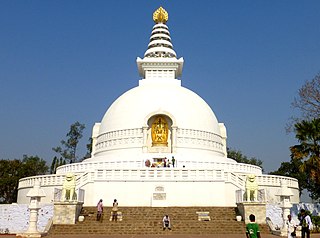
Rajgir, old name Rajagriha, meaning "The City of Kings," is an ancient city and university town in the district of Nalanda in Bihar, India. It was the capital of the Haryanka dynasty, the Pradyota dynasty, the Brihadratha dynasty and the Mauryan Empire, as well as the dwelling ground of historical figures such as Buddha, Mahavira and Bimbisara. Due to its religious significance, the city holds a place of prominence in Hindu, Buddhist and Jain scriptures. As of 2011, the population of the town was reported to be 41,000 while the population in the community development block was about 88,500.
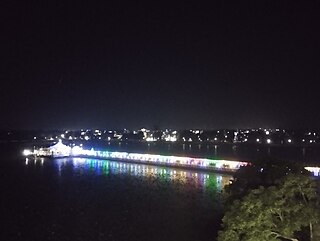
Pawapuri, or Pavapuri, is a holy site for Jains located in the Nalanda district of Bihar state in eastern India. It is located about 19 kilometres from Rajgir and 101 kilometres from Patna, the capital of Bihar. Pawapuri is Mahavira's nirvana and a pilgrimage site for Jains.

Shikharji, also known as Sammet Shikharji or Sammed Shikharji, is one of the holiest pilgrimage sites for Jains, in Giridih district, Jharkhand. It is located on Parasnath hill, the highest mountain in the state of Jharkhand. It is the most important Jain Tirtha, for it is the place where twenty of the twenty-four Jain tirthankaras along with many other monks attained Moksha. It is one of the seven principal pilgrimage destinations along with Girnar, Pawapuri, Champapuri, Dilwara, Palitana and Ashtapad Kailash.

Vaishali, Vesali or Vaiśālī was an ancient city located in present-day Bihar, India. It is now an archaeological site and forms part of the Vaishali District in Tirhut Division.
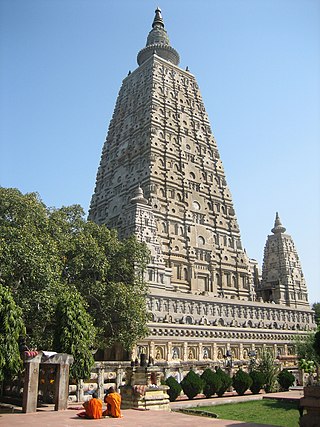
The state of Bihar in eastern India, is one of the oldest inhabited places in the world with a history going back 3000 years. The rich culture and heritage of Bihar is evident from the innumerable ancient monuments that are dotted all over the state. Bihar is home to many tourist attractions and is visited by large numbers of tourists from all over the world. Around total 6 million tourists visit Bihar every year.
Hinduism is the most followed religion in Bihar, followed by nearly 82% of total population as per 2023 Bihar Caste based census. Islam is the second-most followed religion which is followed by nearly 17.7% of population. There is also a significant population of Buddhists and Christians in the state.

Kulpakji also Kolanupaka Temple is a 2,000 year-old Śvetāmbara Jain temple in the village of Kolanupaka in Aler City, Yadadri Bhuvanagiri district, Telangana, India. The temple houses three deities: one each of Lord Rishabhanatha, Lord Neminatha, and Lord Mahavira. The image of Lord Mahavir, carved of a green stone has been historically famous as "Manikyaswami" and Jivantasvami. The temple is about 80 km from Hyderabad on the Hyderabad-Warangal Highway NH 163.
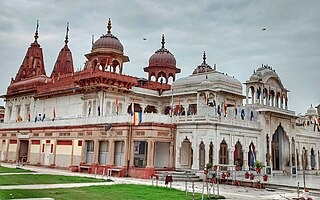
Shri Mahavir Ji is an important and prominent Jain pilgrimage site situated in Shri Mahaveerji town in Hindaun Block, Karauli district in Rajasthan. Given the importance of the religious place, the Indian Railways has specifically developed a railway station under West Central Railway zone by the name of Shri Mahaveerji railway station which is 10 minutes drive from the temple and temple authorities have arranged for regular buses from the station to the temple. The temple is visited by millions of Jain and Hindu devotees every year.

Kundalpur is a village in Nalanda district in the Indian state of Bihar. It is located about 2.5 kilometres from ancient Nalanda Mahavihara, 11 kilometres southwest of Bihar Sharif, and 80 kilometres southeast of Patna.
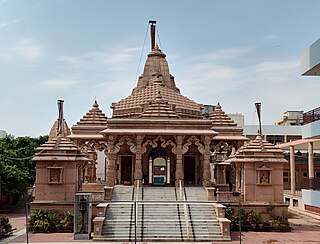
Parshvanath Jain temples, Varanasi is a group of three Jain temples located in Bhelupur, Uttar Pradesh. The temples in Bhelupur were built to commemorate place for three kalyanaka of Parshvanatha.

Ancient idols of Jain Tirthankara were found in archaeological expeditions in Badli, Bhiwani, Dadri, Gurgaon, Hansi, Hisar (Agroha), Kasan, Nahad, Narnaul, Pehowa, Rewari, Rohad, Rohtak and Sonepat in Haryana. Agrawal Jain community traces its origins from Hisar. Guptisagar Dham Tirtha at Ganaur is a religious tourist spot in Haryana. It is named after the Jain Acharya Guptisagar.

The Jal Mandir or Water Temple is situated in Pawapuri, in the Indian state of Bihar. It is dedicated to Mahavira, the 24th Tirthankara, which marks the place of his cremation. Mahavira attained Nirvana (death) in Pawapuri in 527 BC. The temple was originally built by King Nandivardhan, elder brother of Mahavira, within the pond which is filled with red coloured lotus flowers. It is one of the five main temples in Pawpuri, where the "Charan Paduka" or foot impression of Mahavira is deified.

Jainism in Bihar trace a long history since the times of twenty-fourth Tirthankara Mahavira, who was born in Vaishali. The state of Bihar is considered to have played an important role in the development of Jainism.
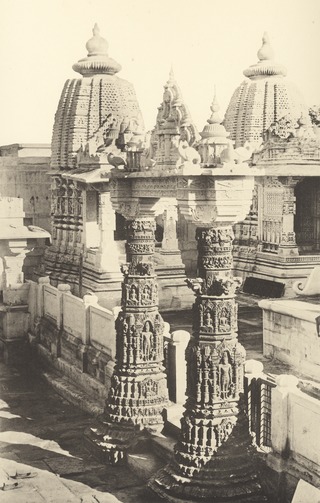
The Mahavira Jain temple is built in Osian of Jodhpur District, Rajasthan. The temple is an important pilgrimage of the Oswal Jain community. This temple is the oldest surviving Jain temple in Western India and was built in 457 BC.
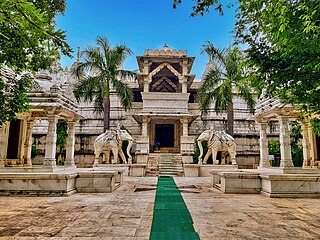
The Kumbharia Jain temples is a group of five Jain temples in the Kumbhariya, Banaskantha district in Gujarat, India. Constructed from 1062 to 1231 CE during the reign of the Chaulukya dynasty, they are noted for their elaborate architecture.

Sarnath Jain Tirth, also called the Shreyanshnath Jain Pilgrimage, is a group of Jain temples in Sarnath. They are located near Dhamek Stupa.

The Kamaldah Jain temple, located in Patna, Bihar, is one of the oldest Jain temples belonging to the Śvētāmbara sect of Jainism.

Jain temple, Kundalpur is a complex of six Jain temples located in Kundalpur village near Nalanda, Bihar. Kundalpur is one of the most important Jain pilgrimages in Bihar.



















